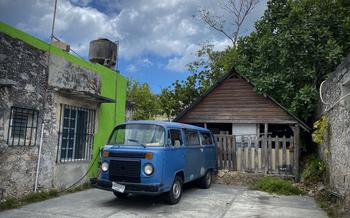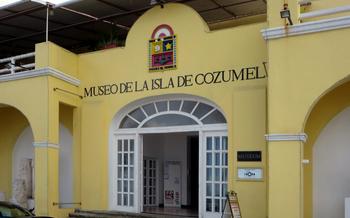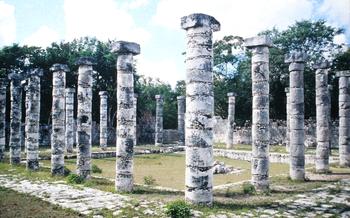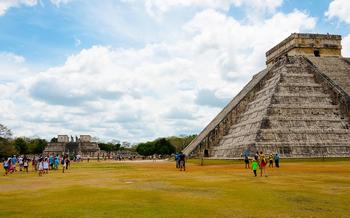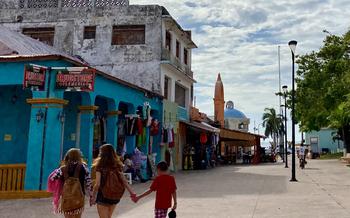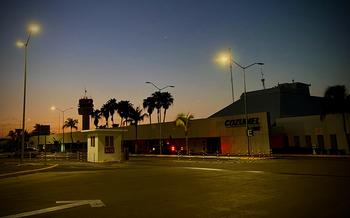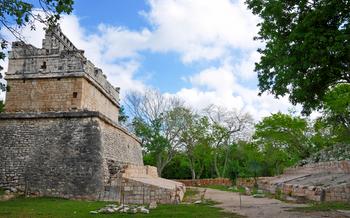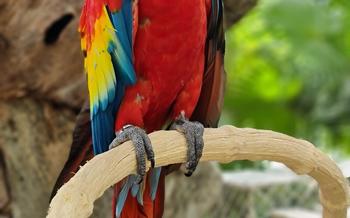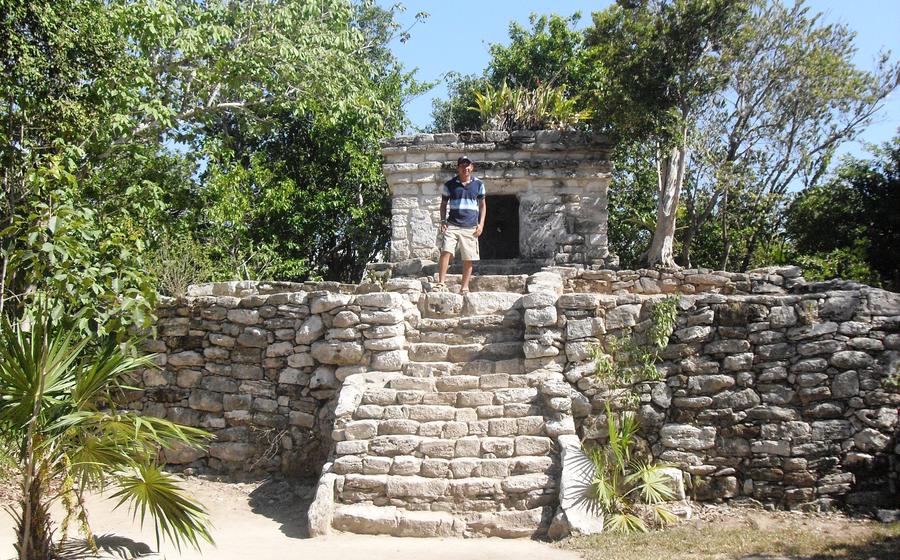
San Gervasio Mayan Archaeological Site, Cozumel
- Historical significance of the site:
- Getting to San Gervasio:
- Exploring the Main Plaza:
- The Temple of the Wind: A Sacred Place of Astronomical Significance
- The Sacred Cenote
- The Observatory
- The Ball Court
- The Stelae and Altars
- The Surrounding Jungle: A Haven of Biodiversity
- Cultural Performances
- Interactive Workshops: Embracing Mayan Craftsmanship
- Souvenir Shopping
- Dining Options
- Insider Tip: Embracing the Magic of San Gervasio
Historical significance of the site:
Uniqueness: San Gervasio stands out for its unique architectural style, featuring rounded corners and corbelled vaults that set it apart from other Mayan sites.
Ancient Capital: It served as the ceremonial and political center of Cozumel during the Postclassic period, making it a significant site for understanding the island's history.
Pilgrimage Site: The island was considered sacred by the Maya, and San Gervasio was a pilgrimage site for worshippers seeking blessings from the goddess Ixchel, particularly for childbirth and healing.
Getting to San Gervasio:
To reach San Gervasio from Cozumel's main town, you have several transportation options. You can hire a taxi or rent a car for a comfortable and customizable journey. Taxis are readily available and can be negotiated for a round trip or an hourly rate. Renting a car offers more flexibility and allows you to explore the island at your own pace. However, be prepared for limited parking availability near the site.
For a more immersive experience, consider joining a guided tour. These tours typically depart from the main town and include transportation, entrance fees, and the services of a knowledgeable guide. Guided tours offer insights into the history, culture, and significance of the site, enhancing your understanding of the ancient Mayan civilization.
If you prefer self-guided exploration, you can take the local bus from the main town to the San Gervasio entrance. Buses are affordable and reliable, but they may be crowded during peak tourist season. Once you arrive at the site, you can purchase an entrance ticket and explore at your own leisure. Renting a bicycle is another option for getting around the site, allowing you to cover more ground and enjoy the surrounding scenery.
Exploring the Main Plaza:
The Main Plaza, also known as the Grand Plaza, is the heart of the San Gervasio archaeological site. It served as the central gathering space for the ancient Maya community and was a place for important ceremonies and rituals.
The Main Plaza is a large, open area surrounded by several notable structures. The most prominent is the Temple of the Wind, which stands on the western side of the plaza. Other structures include the Sacbe, a raised walkway leading from the Main Plaza to the Sacred Cenote, and the Temple of the Masks, which features intricate carvings of human faces.
The Main Plaza was a place of great significance for the Maya. It was here that they gathered for religious ceremonies, political meetings, and market days. It was also a place for social gatherings and celebrations.
The Temple of the Wind: A Sacred Place of Astronomical Significance
The Temple of the Wind stands tall and proud, its intricate carvings a testament to the architectural prowess of the ancient Maya. This pyramid-shaped structure is the most impressive building in San Gervasio, and its significance extends beyond its physical beauty.
With its elevated position, the temple offers panoramic views of the surrounding jungle and the Caribbean Sea. This strategic location allowed the Maya priests to observe celestial events such as the solstices and equinoxes. The temple's alignment with these astronomical phenomena suggests an advanced understanding of the cosmos.
Inside the temple, visitors can find a series of chambers and passageways. These spaces were used for religious ceremonies and other rituals, and their walls are adorned with intricate carvings and paintings. These artworks depict scenes from Mayan mythology and provide valuable insights into their beliefs and practices.
The Temple of the Wind is a testament to the Maya's deep connection to the natural world and their profound understanding of astronomy. It is a place of awe and inspiration, and it continues to captivate visitors with its beauty and spiritual significance.
The Sacred Cenote
The Sacred Cenote, a natural sinkhole with crystal-clear waters, holds profound significance in Mayan culture. Believed to be a gateway to the underworld, it served as a site for religious rituals and offerings to the deities. The Maya revered cenotes as sources of life and considered them sacred portals connecting the physical and spiritual realms.
Descend the ancient stone steps leading to the cenote's edge and marvel at the mesmerizing sight of the deep blue waters. Take a refreshing dip in the cool, clear waters and experience the tranquility of this sacred site. Snorkeling enthusiasts can explore the underwater world and witness the diverse marine life that inhabits the cenote.
As you float amidst the serene waters, immerse yourself in the mystical energy that envelops this place. Imagine the ancient Maya performing their rituals, making offerings, and seeking guidance from the deities. The Sacred Cenote offers a unique opportunity to connect with the spiritual essence of the ancient Mayan civilization.
The Observatory
The Observatory at San Gervasio stands as a testament to the advanced astronomical knowledge of the ancient Maya. This impressive structure, with its distinctive circular shape and strategically placed windows, served as a celestial observatory for the Maya to track the movements of the sun, moon, and stars.
The Observatory's alignment with specific celestial events, such as the solstices and equinoxes, allowed the Maya to accurately predict seasonal changes and plan their agricultural activities accordingly. The structure's design also enabled them to observe and study astronomical phenomena, contributing to their understanding of the cosmos and their place within it.
Intricate carvings and symbols adorn the walls of the Observatory, depicting celestial bodies and constellations that held deep religious and cultural significance for the Maya. These intricate carvings not only showcase the Maya's artistic prowess but also provide valuable insights into their sophisticated knowledge of astronomy.
The Ball Court
The ball game, known as "pok-ta-pok" or "tlachtli," held a significant place in Mayan culture. It was more than just a sport; it had religious and ritualistic connotations. The ball court at San Gervasio is a testament to the importance of this game and showcases the architectural prowess of the Maya.
This rectangular court, measuring approximately 155 feet long by 66 feet wide, features two parallel walls with stone rings embedded in them. These rings, the goals of the game, were placed at a considerable height, requiring skill and precision from the players.
The game was played with a solid rubber ball, and the objective was to keep the ball in play without using one's hands. Players could only use their hips, shoulders, and elbows to hit the ball and maneuver it through the stone rings.
The outcome of the game had symbolic and ritualistic implications. Victories were believed to bring favor from the gods, while defeats could have dire consequences. The ball game was also seen as a representation of the cosmic struggle between light and darkness, with the ball representing the sun.
Beyond its religious significance, the ball game was also a form of entertainment and a way for the Maya to showcase their physical prowess and agility. The San Gervasio ball court stands as a testament to the cultural and ritualistic importance of the game in Mayan society.
The Stelae and Altars
Elaborate Stone Narratives:
Amidst the ruins of San Gervasio, the stelae and altars stand as testaments to the rich artistic and cultural heritage of the Mayans. These intricately carved stones narrate tales of history, mythology, and religious beliefs, offering valuable insights into the minds and hearts of this ancient civilization.
Crafted from limestone or sandstone, these monuments vary in size and complexity, each adorned with a unique array of glyphs, symbols, and figures. Some depict historical events, such as the accession of a new ruler or the commemoration of a significant battle. Others showcase scenes from Mayan mythology, featuring deities, heroes, and supernatural creatures engaged in various narratives.
The stelae often feature a central figure, usually a ruler or a priest, depicted in elaborate regalia and surrounded by a retinue of attendants or deities. The glyphs accompanying these figures provide information about their names, titles, and accomplishments, as well as the dates of important events.
The altars, which often accompanied the stelae, served as platforms for offerings and rituals. They are typically smaller in size and less elaborately carved, but they often feature similar motifs and symbols as the stelae. Together, these monuments offer a glimpse into the complex religious practices and beliefs of the ancient Maya.
Studying the stelae and altars at San Gervasio provides a unique opportunity to understand the rich symbolism and narrative traditions of the Mayan civilization. These stones offer a window into the minds and hearts of this ancient people, allowing us to connect with their history, culture, and beliefs in a profound and meaningful way.
The Surrounding Jungle: A Haven of Biodiversity
The San Gervasio Mayan Archaeological Site is not just about ancient ruins, but also about the breathtaking natural beauty that surrounds it. Visitors can immerse themselves in the lush tropical jungle that envelops the site. The area boasts a rich biodiversity, with a diverse range of plant and animal life.
Keep an eye out for exotic birds flitting through the trees, their colorful plumage adding vibrancy to the jungle. The jungle is also home to various reptiles, including iguanas and snakes, as well as small mammals like monkeys and raccoons.
Take some time to wander off the main paths and explore the jungle's hidden corners. You might stumble upon a secluded cenote, a natural swimming hole revered by the ancient Maya. These pristine waters offer a refreshing respite from the tropical heat and provide an opportunity for a unique swimming experience.
Whether you're a nature enthusiast or simply seeking a tranquil retreat, the surrounding jungle at San Gervasio is sure to captivate your senses and leave you with lasting memories of your visit to this ancient Mayan city.
Cultural Performances
Immerse yourself in the rich cultural heritage of the Mayans through captivating performances that bring their ancient traditions to life. Witness the grace and agility of traditional Mayan dancers as they showcase their intricate steps and vibrant costumes. The rhythmic beats of drums and the melodious tunes of flutes fill the air, creating an enchanting atmosphere that transports you back in time.
These performances are not just a spectacle; they are a testament to the enduring spirit of the Mayan people. Each dance, each song, and each movement carries deep cultural significance, offering a glimpse into their beliefs, rituals, and way of life. Learn about the stories and legends that have been passed down through generations, and gain a deeper appreciation for the rich tapestry of Mayan culture.
Interactive Workshops: Embracing Mayan Craftsmanship
San Gervasio offers a unique opportunity to delve deeper into Mayan culture through interactive workshops. Visitors can immerse themselves in the art of traditional Mayan crafts, guided by skilled artisans who share their knowledge and techniques. From intricate textile weaving and pottery making to colorful beadwork and wood carving, there's something for every interest and skill level.
These workshops provide a hands-on experience, allowing visitors to create their own unique souvenirs while learning about the cultural significance and symbolism behind each craft. Whether it's creating a vibrant woven bracelet, molding a clay pot, or designing a beaded necklace, the workshops offer a glimpse into the creativity and artistry of the ancient Maya.
In addition to learning new skills, the workshops foster a deeper appreciation for Mayan culture and traditions. They showcase the continuity of Mayan craftsmanship, passed down through generations, and highlight the importance of preserving and supporting indigenous arts and crafts.
Participating in these workshops not only enriches the San Gervasio experience but also contributes to the preservation and promotion of Mayan cultural heritage. Visitors leave with a unique souvenir, a newfound respect for Mayan craftsmanship, and a deeper connection to the ancient civilization.
Souvenir Shopping
As you explore San Gervasio, you'll come across local vendors selling a variety of handmade crafts, providing a unique opportunity to take home a piece of Mayan culture. These vendors offer a diverse selection of souvenirs, including intricate textiles, colorful pottery, hand-carved wooden figurines, and woven baskets.
Each item is meticulously crafted by local artisans using traditional techniques passed down through generations. By purchasing souvenirs from these vendors, you not only get a unique memento of your visit but also support the local community and their efforts to preserve their cultural heritage.
Whether you're looking for a vibrant textile to brighten your home décor, a one-of-a-kind piece of pottery to add to your collection, or a meaningful gift for a loved one, the San Gervasio souvenir market has something for everyone. Take some time to browse the stalls, engage with the friendly vendors, and discover the beauty and craftsmanship of Mayan art. Your purchase will not only serve as a reminder of your visit to this ancient city but also contribute to the sustainability of the local community.
Dining Options
When visiting San Gervasio, you'll find several dining options to satisfy your appetite. Within the archaeological park, there's a restaurant that offers a delightful menu featuring both traditional Mayan cuisine and international dishes. Savor the flavors of ancient Maya recipes passed down through generations, such as Poc Chuc, a grilled pork dish marinated in achiote sauce, or indulge in international favorites like pasta and burgers.
As you explore the surrounding area, you'll discover charming local restaurants just a short walk from the ruins. These restaurants offer a more intimate dining experience, allowing you to immerse yourself in the local culture. Enjoy fresh seafood dishes, tacos made with handmade tortillas, or traditional Mayan soups, all prepared with local ingredients and infused with authentic flavors.
Whether you choose to dine within the archaeological park or venture out to nearby restaurants, you'll have the opportunity to savor delicious food while surrounded by the beauty and history of San Gervasio. Take your time to enjoy a leisurely meal, soak in the atmosphere, and make your visit to this ancient Mayan city a truly memorable experience.
Insider Tip: Embracing the Magic of San Gervasio
To fully immerse yourself in the enchantment of San Gervasio, plan your visit for the early morning or late afternoon when the sun's golden rays illuminate the ruins, casting long shadows that enhance their grandeur. This timing not only provides optimal lighting for capturing stunning photographs but also allows you to escape the midday crowds, ensuring a more serene and intimate exploration. Embrace the tranquility of the site, allowing yourself to connect with the ancient spirits that once inhabited these grounds.
